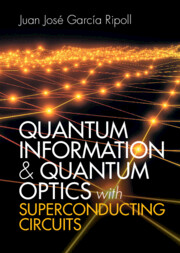Book contents
- Frontmatter
- Contents
- Figures
- Tables
- Notation
- 1 Introduction
- 2 Quantum Mechanics
- 3 Superconductivity
- 4 Quantum Circuit Theory
- 5 Microwave Photons
- 6 Superconducting Qubits
- 7 Qubit–Photon Interaction
- 8 Quantum Computing
- 9 Adiabatic Quantum Computing
- Appendix A Hamiltonian Diagonalizations
- Appendix B Open Quantum Systems
- References
- Index
4 - Quantum Circuit Theory
Published online by Cambridge University Press: 04 August 2022
- Frontmatter
- Contents
- Figures
- Tables
- Notation
- 1 Introduction
- 2 Quantum Mechanics
- 3 Superconductivity
- 4 Quantum Circuit Theory
- 5 Microwave Photons
- 6 Superconducting Qubits
- 7 Qubit–Photon Interaction
- 8 Quantum Computing
- 9 Adiabatic Quantum Computing
- Appendix A Hamiltonian Diagonalizations
- Appendix B Open Quantum Systems
- References
- Index
Summary
In this chapter, we develop the conditions to observe quantum fluctuations and quantum phenomena (entanglement, superpositions, etc.) in quantum circuits. Assuming the right conditions of temperature, we develop the quantum mechanical theory that models those fluctuations in a circuit built from nondissipative superconducting elements. We use this theory of circuit quantization to obtain the quantum Hamiltonians for microwave resonators and waveguides, for superconducting qubits of various types, and for other elements such as SQUIDs. The chapter closes with an illustration of how the same theory provides us with numerical methods to study the eigenstates, eigenenergies, and dynamics of said Hamiltonians.
Keywords
Information
- Type
- Chapter
- Information
- Publisher: Cambridge University PressPrint publication year: 2022
